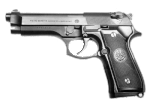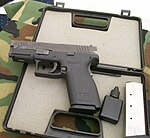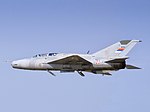You've missed my point again.
Who cares if it's ISIS, The Taliban, AQ, Al-Shabaab or anyone else? All terrorists are terrorists in the end.
The total force size has been estimated from tens of thousands to over two hundred thousand.
[h=2]Weapons[edit][/h][h=3]Conventional weapons[edit][/h]The most common weapons used against US and other Coalition forces during the Iraq insurgency were those taken from Saddam Hussein's weapon stockpiles around the country. These included AKM variant assault rifles, PK machine guns and RPG-7s.[SUP][108][/SUP] ISIL has been able to strengthen its military capability by capturing large quantities and varieties of weaponry during the Syrian Civil War and Post-US Iraqi insurgency. These weapons seizures have improved the group's capacity to carry out successful subsequent operations and obtain more equipment.[SUP][109][/SUP] Weaponry that ISIL has reportedly captured and employed include SA-7[SUP][110][/SUP] and Stinger[SUP][111][/SUP] surface-to-air missiles, M79 Osa, HJ-8[SUP][112][/SUP] and AT-4 Spigot[SUP][110][/SUP] anti-tank weapons, Type 59 field guns[SUP][112][/SUP] and M198 howitzers,[SUP][113][/SUP] Humvees, T-54/55, T-72, and M1 Abrams[SUP][114][/SUP] main battle tanks,[SUP][112][/SUP] M1117 armoured cars,[SUP][115][/SUP] truck-mounted DShK guns,[SUP][110][/SUP] ZU-23-2 anti-aircraft guns,[SUP][116][/SUP][SUP][117][/SUP] BM-21 Grad multiple rocket launchers,[SUP][109][/SUP] and at least one Scud missile.[SUP][118][/SUP]
ISIL shot down an Iraqi helicopter in October 2014, and claims to have shot down "several other" helicopters in 2014. Observers fear that they have "advanced surface-to-air missile systems" such as the Chinese-made FN-6, which are thought to have been provided to Syrian rebels by Qatar and/or Saudi Arabia, and purchased or captured by ISIL.[SUP][119][/SUP]
[h=3]Aircraft[edit][/h]When ISIL captured Mosul Airport in June 2014, it seized a number of UH-60 Blackhawk helicopters and cargo planes that were stationed there.[SUP][120][/SUP][SUP][121][/SUP] According to Peter Beaumont of The Guardian, it seemed unlikely that ISIL would be able to deploy them.[SUP][122][/SUP]
ISIL also captured fighter aircraft in Syria. The Syrian Observatory for Human Rights reported in October 2014 that former Iraqi pilots were training ISIL militants to fly captured Syrian jets. Witnesses reported that MiG-21 and MiG-23 jets were flying over al-Jarrah military airport, but the US Central Command said it was not aware of flights by ISIL-operated aircraft in Syria or elsewhere.[SUP][123][/SUP] On 21 October, the Syrian Air Force claimed that it had shot down two of these aircraft over al-Jarrah air base while they were landing.[SUP][124][/SUP]
[h=3]Non-conventional[edit][/h]ISIL captured nuclear materials from Mosul University in July 2014. In a letter to UN Secretary-General Ban Ki-moon, Iraq's UN Ambassador Mohamed Ali Alhakim said that the materials had been kept at the university and "can be used in manufacturing weapons of mass destruction". Nuclear experts regarded the threat as insignificant. International Atomic Energy Agency spokeswoman Gill Tudor said that the seized materials were "low grade and would not present a significant safety, security or nuclear proliferation risk".[SUP][125][/SUP][SUP][126][/SUP]
Reports suggest that ISIL captured Saddam era chemical weapons from an Iraqi military base[SUP][127][/SUP] and has deployed chlorine gas based chemical weapons against Iraqi Government forces, Syrian Government and Syrian Opposition Forces,[SUP][128][/SUP] and unidentified chemical weapons against Kurds in Kobanî, Syria.
ISIL has a long history of using truck and car bombs, suicide bombers, and IEDs.
[h=2]Equipment table of commonly used weapons[edit][/h][h=3]Infantry weapons[edit][/h][h=4]Assault Rifles[edit][/h]
| Name | Type | Quantity | Origin | Photo | Notes |
|---|---|---|---|---|---|
| AKM | Assault Rifle |

|

| Captured from Syrian and Iraqi Army | |
| AK 47 | Selective fire Assault Rifle | 8000+[SUP][129][/SUP] |

|

| Most commonly used |
| Type 56 assault rifle | Assault Rifle |

|

| Captured from Syrian Army | |
| Zastava M70 | Assault Rifle |

|

| Captured from Iraqi Army and Police | |
| M16 rifle | Assault Rifle | 1000+[SUP][129][/SUP] |

|

| Captured from Iraqi Army & Police; manufactured by FNand Colt [SUP][130][/SUP] |
| M4A1 SOPMOD (Limited)[SUP][131][/SUP] | Carbine Rifle |

|

| Captured from Iraqi Army & Police | |
| H&K G36[SUP][131][/SUP] | Assault Rifle |

|

| ||
| Steyr AUG | Assault Rifle |

|

|
| Name | Type | Quantity | Origin | Photo | Notes |
|---|---|---|---|---|---|
| Dragunov SVD | Designated marksman rifle | 3000+[SUP][129][/SUP] |

|

| |
| PSL/FPK[SUP][132][/SUP] | Designated marksman rifle |

|

| ||
| M14 EBR (Limited) | Designated marksman rifle |

|

| Captured from Iraqi Army [SUP][133][/SUP](8:40 mins) [SUP][134][/SUP] | |
| Mosin Nagant | Sniper rifle |

|

| Equipped with PU, PE, and modified PSO-1scopes [SUP][135][/SUP] [SUP][136][/SUP] | |
| KSVK 12.7 | Anti-materiel rifle |

|

| ||
| M99 | Anti-materiel rifle | [SUP][129][/SUP] |

|
| Name | Type | Quantity | Origin | Photo | Notes |
|---|---|---|---|---|---|
| RPD | Light machine gun | [SUP][129][/SUP] |

|

| |
| RPK | Light machine gun | [SUP][129][/SUP] |

|

| |
| PKM | Squad automatic weapon | [SUP][129][/SUP] |

|

| Most common belt-fed machine gun used |
| M249 light machine gun[SUP][137][/SUP] | Squad automatic weapon |

|

| ||
| FN Minimi | Light machine gun |

|

| Captured from Iraqi Army & Police | |
| PKP Pecheneg | Light machine gun |

|

| Mostly from black markets or Chechen separatists. | |
| NSV machine gun | Heavy machine gun | [SUP][129][/SUP] |

|

| |
| DShK | Heavy machine gun | [SUP][129][/SUP] |

|

|
| Name | Type | Quantity | Origin | Photo | Notes |
|---|---|---|---|---|---|
| Beretta 92 | Semi-automatic pistol |

|

| Captured from Iraqi Army & Police | |
| Glock 17 | Semi-automatic pistol |

|

| Captured from Iraqi Army & Police | |
| HS2000 | Semi-automatic pistol |

|

| Captured from Iraqi Army & Police [SUP][138][/SUP] | |
| Makarov PM | Semi-automatic pistol |

|

| ||
| Browning Hi-Power[SUP][139][/SUP] | Semi-automatic pistol |

|

|
| Name | Type | Quantity | Origin | Photo | Notes |
|---|---|---|---|---|---|
| IED | Improvised explosive device |

|

| Most commonly used | |
| M62 grenade | Hand grenade |

| Multiple caches[SUP][140][/SUP] | ||
| Milkor MGL | Grenade launcher |

|

| ||
| RPG-7 | Rocket propelled grenade launcher |

|

| Commonly used | |
| M40 recoilless rifle | Recoilless rifle |

|

| Possibly rarely used | |
| FN-6[SUP][141][/SUP] | MANPADS |

| Reportedly used in 3 October 2014 in Baiji to shoot down an Iraqi Mi‑35M helicopter.[SUP][141][/SUP] | ||
| FIM-92 Stinger[SUP][142][/SUP] | MANPADS |

|

| ||
| SA-7 Grail[SUP][141][/SUP] | MANPADS |

|

| "limited, aging stock" | |
| SA-16 Gimlet[SUP][142][/SUP] | MANPADS |

|

| ||
| SA-24 Grinch[SUP][142][/SUP] | MANPADS |

|

| ||
| BGM-71 TOW[SUP][143][/SUP] | Wire-guided anti-tank missile |

|

| ||
| MILAN | Wire-guided anti-tank missile |

|

| ||
| HJ-8 | Wire-guided anti-tank missile |

|

|
| Name | Type | Quantity | Origin | Photo | Notes |
|---|---|---|---|---|---|
| Nimr | Infantry Mobility Vehicle | small amount |

|

| Captured from the Libyan National Army in takeover of Derna |
| HMMWV | Light Utility Vehicle | +500[SUP][144][/SUP][SUP][145][/SUP][SUP][146][/SUP][SUP][147][/SUP] |

|

| Many captured |
| Ain Jaria-1 | Infantry Mobility Vehicle | dozens |

|

| |
| Cougar MRAP | Light Utility Vehicle | unknown |
 United States
United States |

| |
| Technicals | improvised fighting vehicles | varies |

|

| |
| M939 Truck | 6×6 truck | unknown |
 United States
United States |

| Capture in Camp Saqlawiyah and Camp Speicher |
| Medium Tactical Vehicle Replacement | 6×6 truck | 300+ |
 United States
United States |

| Captured during the Fall of Mosul. |
| Name | Type | Quantity | Origin | Photo | Notes |
|---|---|---|---|---|---|
| BRDM-2 | Amphibious Armoured Scout Car | a few hundred |

|

| Captured from the Syrian Army |
| BMP-1 | Armored personnel carrier | 20[SUP][148][/SUP] |

|

| Captured from the armies of Iraq and Syria |
| MRAP | Armored personnel carrier | 13[SUP][148][/SUP] |

|

| Captured from the Iraqi Army and Police |
| M1117 Armored Security Vehicle | Armored personnel carrier | 47[SUP][148][/SUP] |

|

| Captured from the Iraqi Army and Police |
| T-55/55MV/AM/AMV | Main battle tank | 30[SUP][149][/SUP] |

|

| |
| MT-LB[SUP][150][/SUP] | Armored personnel carrier | ~50 |

|

| |
| T-62M/K | Main battle tank | 100+ |

|

| |
| T-72/72M/A/AV /TURMS-T/M1 TURMS-T | Main battle tank | 5 to 10[SUP][149][/SUP] |

|

| |
| M113 APC | Armored personnel carrier | unknown number |

|

| Captured from the Iraqi Army[SUP][149][/SUP] |
| M1A1M Abrams | Main battle tank | 1-2 (rumored)[SUP][149][/SUP] |

|

| Captured from the Iraqi Army[SUP][149][/SUP] |
| Name | Type | Quantity | Origin | Photo | Notes |
|---|---|---|---|---|---|
| ZSU-23-4 Shilka[SUP][142][/SUP] | Self-propelled anti-aircraft gun | small numbers |

|

| Captured from Syrian army |
| 2S1 Gvozdika | Self-propelled artillery | 3 (est.)[SUP][148][/SUP] |

|

| Captured from the Syrian army |
| M198 Howitzer | Towed howitzer | Up to 52[SUP][151][/SUP] |

|

| |
| BM-21 Grad[SUP][148][/SUP] | Multiple Rocket Launcher |

|

| ||
| ZU-23-2[SUP][148][/SUP] | Towed Anti-Aircraft Twin Autocannon |

|

| ||
| AZP S-60[SUP][142][/SUP] | Anti-Aircraft Gun |

|

| ||
| Type 59-1[SUP][148][/SUP] | Field gun |

|

| ||
| 122-mm howitzer D-30[SUP][148][/SUP] | Field gun |

|

| ||
| BM-14 | Multiple Rocket Launcher |

|

| Captured from Syrian and Libyan National Army. | |
| Scud | tactical ballistic missiles |


| Unknown number of captured Iraqi Scuds |
| Name | Type | Quantity | Origin | Photo | Notes |
|---|---|---|---|---|---|
| Mil Mi-28 orMil Mi-24 | Attack helicopter | 1[SUP][152][/SUP] |

|


| Deployed in Samaraa according to some sources |
| MiG-21 orMiG-23 | Interceptor/Fighter | 3[SUP][153][/SUP][SUP][154][/SUP] |

|


| The Syrian Air Force claimed to have shot down two of them.[SUP][124][/SUP] |
| Mohajer 4Drone and others | Drone (UAV) | 6+[SUP][155][/SUP][SUP][156][/SUP][SUP][157][/SUP][SUP][158][/SUP][SUP][159][/SUP] |

| Some were captured from the Syrian Army and Iran. ISIL demonstrated the use of a reconnaissance drone in "Clanking of the Swords IV" (June 2014) and in October 2014 over Kobanî in the John Cantlie video and also in the Tabqah Air Base video. The three Drones in Syria were shot down over Kobanî by Kurdish forces defending the city,[SUP][160][/SUP][SUP][161][/SUP] and by the Syrian Army over an airbase.[SUP][159][/SUP] |








